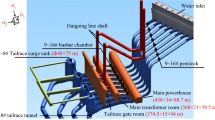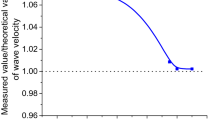Abstract
In the mining process of deep metal mines, different types of rock mass instability failures are caused by strong mining disturbance. It is beneficial to master the fracture mechanism of rock mass in time to effectively prevent and control the ground pressure disasters. Microseismic signals are generated by the propagation and expansion of cracks inside the rock mass that contain plentiful information about the structural changes of rock mass. The ratio of the radiated energy of S and P waves (Es/Ep) of microseismic events can fast and effectively calculate the rock fracture mechanism, which is widely used for ground pressure hazard risk assessment. In this paper, this method was used to analyze the fracture mechanism of rock mass around deep stope in Hongtoushan copper mine and Ashele copper mine. Furthermore, the spatial distribution characteristics and proportion changes of microseismic events with different fracture mechanisms along with the mining process were studied. The results show that tensile cracks play a dominant role, accounting for 62% of the total events, during non-shear fracturing of the rock mass caused by the stoping unloading effect, while shear cracks occupy 68% of the total events during orebody slip failure. When the physical and mechanical properties of the orebody and rock mass are significantly different, slip failure along their contact zone is prone to occur under blasting disturbance. During deep mining, it is necessary to control the exposed area of the roof by each stoping, especially during the earlier mining stage, to avoid tensile stress concentration. The temporal and spatial variation of tension cracks and shear cracks induced by roof damage obtained in this paper can guide the prevention and control of ground pressure disasters in deep mining effectively.
Similar content being viewed by others
References
Abolfazlzade, Y., and Hudym, M., 2016, Identifying and describing a seismogenic zone in a sublevel caving mine: Rock Mechanics and Rock Engineering, 49, 3735–3751.
Boatwright, J., and Fletcher, J.B., 1984, The partition of radiated energy between P and S waves: Bulletin of the Seismological Society of America, 74, 361–376.
Byerly, P, 1928, The nature of the first motion in the Chilean earthquake of November 11, 1922: American Journal Ofence, 19(93), 232–236.
Byerly, P, 1938, The earthquake of July 6, 1934: Amplitudes and First Motion: Bulletin of the Seismological Society of America, 1, 1–13.
Cai, M.F., Xue, D.L., Ren, F.H., 2019, Current status and development strategy of metal mines: Chinese Journal of Engineering, 41(4), 417–426.
Cai, M., Kaiser, P.K., and Martin, C.D., 1998, A tensile model for the interpretation of microseismic events near underground openings: Pure and Applied Geophysics, 153, 67–92.
Cai, M., Kaiser, P.K., and Martin, C.D., 2001, Quantification of rock mass damage in under- ground excavations from microseismic event monitoring: International Journal of Rock Mechanics and Mining Sciences, 38, 1135–1145.
Chang, S.H., and Lee, C.I., 2004, Estimation of cracking and damage mechanisms in rock under triaxial compression by moment tensor analysis of acoustic emission: International Journal of Rock Mechanics and Mining Sciences, 41, 1069–1086.
Feignier, B., and Young, R.P., 1992, Moment tensor inversion of induced microseismic event: Evidence of non-shear failures in the −4>M>−2 moment magnitude range: Geophysical Research Letters, 19, 1503–1506.
Gibowicz, S.J., Young, R.P., Talebi, S., et al., 1991, Source parameters of seismic events at the underground research laboratory in Manitoba, Canada: scaling relations for events with moment magnitude smaller than −2: Bulletin of the Seismological Society of America, 81, 1157–1182.
Guo, L., Dai, F., Xu, N.W., et al., 2017, Characteristic of micro-seismic activity due to excavation for underground powerhouse at Lianghekou hydropower station: China Sciencepaper (in Chinese), 12(19), 2273–2280.
Hardebeck, J.L., Shearer, P.M., 2002, A new method for determining first-motion focal mechanism: Bulletin of the Seismological Society of America, 92(6): 2264–2276.
Hirata, A., Kameoka, Y., and Hirano, T., 2007, Safety management based on detection of possible rockbursts by AE monitoring during tunnel excavation: Rock Mechanics and Rock Engineering, 40, 563–576.
Hudyma, M., and Potvin, Y.H., 2010, An engineering approach to seismic risk management in hardrock mines: Rock Mechanics and Rock Engineering, 43, 891–906.
Jiang, F.X., Ye, G.X., Wang, C.W., et al., 2008, Application of high-precision microseismic monitoring technique to water inrush monitoring in coal mine: Chinese Journal of Rock Mechanics and Engineering (in Chinese), 27(9), 1932–1938.
Kwiatek, G., and Ben-Zion, Y., 2013, Assessment of P and S wave energy radiated from very small sheartensile seismic events in a deep south African mine: Journal of Geophysical Research: Solid Earth, 118, 3630–3641.
Lesniak, A., and Lsakow, Z., 2009, Space-time clustering of seismic events and hazard assessment in the Zabrze-Bielszowice coal mine, Poland: International Journal of Rock Mechanics and Mining Sciences, 46, 918–928.
Li, J., Wu, S.C., Gao, Y.T., et al., 2014, Review of slope micro-seismic monitoring in open-pit mine: Chinese Journal of Rock Mechanics and Engineering (in Chinese), 33(S2), 3998–4013.
Li, S.L., Yin, X.G., Zheng, W.D., et al., 2005, Research of multi-channel microseismic monitoring system and its application to Fankou lead-zinc mine: Chinese Journal of Rock Mechanics and Engineering (in Chinese), 24(12), 2048–2053.
Liu, J.P., Li, Y.H., Xu, S.D., et al., 2015, Moment Tensor Analysis of Acoustic Emission for Cracking Mechanisms in Rock with a Pre-cut Circular Hole under Uniaxial Compression: Engineering Fracture Mechanics, 135, 206–218.
Liu, J.P., Xu, S.D., Li, Y.H., et al., 2012, Studies of AE time-space evolution characteristics during failure process of rock specimens with prefabricated holes: Chinese Journal of Rock Mechanics and Engineering (in Chinese), 31(12), 2538–2547.
Liu, J.P., Xu, S.D., Li, Y.H., et al., 2019, Analysis of rock mass stability based on mining-induced seismicity: a case study at the Hongtoushan copper mine in China: Rock Mechanics and Rock Engineering, 52, 265–276.
Lu, C.P., Liu, G.J., Liu, Y., et al., 2015, Microseismic multi-parameters characteristics of rockburst hazard induced by hard roof fall and high stress concentration: International Journal of Rock Mechanics and Mining Sciences, 76, 18–32.
Ma, T.H., Tang, C.A., Tang, L.X., et al., 2016, Mechanism of rock burst forcasting based on micro-seismic monitoring technology: Chinese Journal of Rock Mechanics and Engineering (in Chinese), 35(3), 470–482.
Manthei, G., Eisenblatter, J., and Dahm, T., 2001, Moment tensor evaluation of acoustic emission sources in salt rock: Construction and Building Materials, 15, 297–309.
Mccreary, R., McGaughey, J., Potvin, Y., et al., 1992, Results from microseismic monitoring, conventional instrumentation, and tomography surveys in the creation and thinning of a burst-prone sill pillar: Pure and Applied Geophysics, 139, 349–373.
Mendecki, A.J., 1997, Seismic monitoring in mines: London: Chapman & Hall.
Miao, H.X., Jiang, F.X., Song, X.J., et al., 2012, Tomographic inversion for microseismic source parameters in mining: Applied Geophysics, 9(3), 341–348.
Ming, H.J., Feng, X.T., Zhang, C.Q., et al., 2013, Moment tensor analysis of attitude characterization of hard rock newborn fracture surface based on microseismic informations: Rock and Soil Mechanics (in Chinese), 34(6), 1716–1722.
Ohtsu, M., 1991, Simplified moment tensor analysis and unified decomposition of acoustic emission source: application to in situ hydro fracturing test: Journal of Geophysical Research: Solid Earth, 96(B4), 6211–6221.
Salvoni, M., and Dight, P.M., 2016, Rock damage assessment in a large unstable slope from microseismic monitoring-MMG Century mine (Queensland, Australia) case study: Engineering Geology, 210, 45–56.
Tang, L.Z., and Xia, K.W., 2010, Seismological method for prediction of areal rockbursts in deep mine with seismic source mechanism and unstable failure theory: Journal of Central South University of Technology, 17, 947–953.
Tezuka, K., and Niitsuma, H., 2000, Stress estimated using microseismic clusters and its relationship to the fracture system of the Hijiori hot dry rock reservoir: Engineering Geology, 56, 47–62.
Urbancic, T.I., and Trifu, C., 2000, Recent advances in seismic monitoring technology at Canadian mines: Journal of Applied Geophysics, 45, 225–237.
Xu, N.W., Dai, F., Liang, Z.Z., et al., 2014, The dynamic evaluation of rock slope stability considering the effects of microseismic damage: Rock Mechanics and Rock Engineering, 47, 621–642.
Yin, C., 2017. Fault detection based on microseismic events: Applied Geophysics, 14(3), 363–371.
Yin, C.Q., Tao, K., Cui, X.F., et al., 2009, P-wave first-motion focal mechanism solutions and their quality evaluation: Chinese Journal of Geophysics, 52(5), 1402–1411.
Zhao, J.S., Feng, X.T., Jiang, Q., et al., 2018, Analysis of microseismic characteristics and stability of underground caverns in hard rock with high stress using framing excavation method: Rock and Soil Mechanics (in Chinese), 39(3), 1020–2026.
Zhu, Y.Q., Song, Z.P., Zhao, Z.G., 2005, Review of recent foreign research on seismic sources: Recent developments in word seismology (in Chinese), 8, 1–7.
Author information
Authors and Affiliations
Corresponding author
Additional information
This work was financially supported by the National Key Research and Development Program of China (2017YFC0602904), the National Natural Science Foundation of China (51974059), and the Fundamental Research Funds for the Central Universities (N180115010).
Liu Jian-po, Associate professor, studied in Northeastern University from 2002 to 2011, He is presently working in Key Laboratory of Ministry of Education on Safe Mining of Deep Metal Mines of Northeastern University. He is mainly engaged in the research and application of mine microseismic monitoring technology.
Rights and permissions
About this article
Cite this article
Liu, JP., Si, YT., Zhang, CY. et al. Estimation of fracturing mechanisms by the ratio of radiated energy between S and P waves of microseismic events during mining in metal mines. Appl. Geophys. 17, 465–474 (2020). https://doi.org/10.1007/s11770-020-0856-0
Received:
Revised:
Published:
Issue Date:
DOI: https://doi.org/10.1007/s11770-020-0856-0




